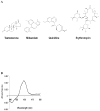Substrate-specific modulation of CYP3A4 activity by genetic variants of cytochrome P450 oxidoreductase
- PMID: 20697309
- PMCID: PMC2940949
- DOI: 10.1097/FPC.0b013e32833e0cb5
Substrate-specific modulation of CYP3A4 activity by genetic variants of cytochrome P450 oxidoreductase
Abstract
Objectives: CYP3A4 receives electrons from P450 oxidoreductase (POR) to metabolize about 50% of clinically used drugs. There is substantial inter-individual variation in CYP3A4 catalytic activity that is not explained by CYP3A4 genetic variants. CYP3A4 is flexible and distensible, permitting it to accommodate substrates varying in shape and size. To elucidate the mechanisms of variability in CYP3A4 catalysis, we examined the effects of genetic variants of POR, and explored the possibility that substrate-induced conformational changes in CYP3A4 differentially affect the ability of POR variants to support catalysis.
Methods: We expressed human CYP3A4 and four POR variants (Q153R, A287P, R457H, A503 V) in bacteria, reconstituted them in vitro and measured the Michaelis constant and maximum velocity with testosterone, midazolam, quinidine and erythromycin as substrates.
Results: POR A287P and R457H had low activity with all substrates; Q153R had 76-94% of wild-type (WT) activity with midazolam and erythromycin, but 129-150% activity with testosterone and quinidine. The A503 V polymorphism reduced the CYP3A4 activity to 61-77% of WT with testosterone and midazolam, but had nearly WT activity with quinidine and erythromycin.
Conclusion: POR variants affect CYP3A4 activities. The impact of a POR variant on catalysis by CYP3A4 is substrate-specific, probably because of substrate-induced conformational changes in CYP3A4.
Figures


Similar articles
-
Effects of genetic variants of human P450 oxidoreductase on catalysis by CYP2D6 in vitro.Pharmacogenet Genomics. 2010 Nov;20(11):677-86. doi: 10.1097/FPC.0b013e32833f4f9b. Pharmacogenet Genomics. 2010. PMID: 20940534 Free PMC article.
-
Effect of P450 oxidoreductase variants on the metabolism of model substrates mediated by CYP2C9.1, CYP2C9.2, and CYP2C9.3.Pharmacogenet Genomics. 2012 Aug;22(8):590-7. doi: 10.1097/FPC.0b013e3283544062. Pharmacogenet Genomics. 2012. PMID: 22547083
-
Altered human CYP3A4 activity caused by Antley-Bixler syndrome-related variants of NADPH-cytochrome P450 oxidoreductase measured in a robust in vitro system.Drug Metab Dispos. 2012 Apr;40(4):754-60. doi: 10.1124/dmd.111.042820. Epub 2012 Jan 17. Drug Metab Dispos. 2012. PMID: 22252407 Free PMC article.
-
Clinical, structural and functional implications of mutations and polymorphisms in human NADPH P450 oxidoreductase.Fundam Clin Pharmacol. 2007 Aug;21(4):399-410. doi: 10.1111/j.1472-8206.2007.00520.x. Fundam Clin Pharmacol. 2007. PMID: 17635179 Review.
-
P450 oxidoreductase deficiency: a new disorder of steroidogenesis.Ann N Y Acad Sci. 2005 Dec;1061:100-8. doi: 10.1196/annals.1336.012. Ann N Y Acad Sci. 2005. PMID: 16467261 Review.
Cited by
-
Influence of various polymorphic variants of cytochrome P450 oxidoreductase (POR) on drug metabolic activity of CYP3A4 and CYP2B6.PLoS One. 2012;7(6):e38495. doi: 10.1371/journal.pone.0038495. Epub 2012 Jun 12. PLoS One. 2012. PMID: 22719896 Free PMC article.
-
Cytochrome P450 oxidoreductase genetic polymorphisms A503V and rs2868177 do not significantly affect warfarin stable dosage in Han-Chinese patients with mechanical heart valve replacement.Eur J Clin Pharmacol. 2013 Oct;69(10):1769-75. doi: 10.1007/s00228-013-1544-2. Epub 2013 Aug 16. Eur J Clin Pharmacol. 2013. PMID: 23949431 Clinical Trial.
-
Identification of cytochrome P450 oxidoreductase gene variants that are significantly associated with the interindividual variations in warfarin maintenance dose.Drug Metab Dispos. 2011 Aug;39(8):1433-9. doi: 10.1124/dmd.111.038836. Epub 2011 May 11. Drug Metab Dispos. 2011. PMID: 21562147 Free PMC article.
-
Genetic variations in NADPH-CYP450 oxidoreductase in a Czech Slavic cohort.Pharmacogenomics. 2015;16(3):205-15. doi: 10.2217/pgs.14.169. Pharmacogenomics. 2015. PMID: 25712184 Free PMC article.
-
Variability in Loss of Multiple Enzyme Activities Due to the Human Genetic Variation P284T Located in the Flexible Hinge Region of NADPH Cytochrome P450 Oxidoreductase.Front Pharmacol. 2019 Oct 15;10:1187. doi: 10.3389/fphar.2019.01187. eCollection 2019. Front Pharmacol. 2019. PMID: 31749697 Free PMC article.
References
-
- Ono T, Bloch K. Solubilization and partial characterization of rat liver squalene epoxidase. J Biol Chem. 1975;250:1571–1579. - PubMed
-
- Nishino H, Ishibashi T. Evidence for requirement of NADPH-cytochrome P450 oxidoreductase in the microsomal NADPH-sterol Delta7-reductase system. Arch Biochem Biophys. 2000;374:293–298. - PubMed
-
- Wilks A, Black SM, Miller WL, Ortiz de Montellano PR. Expression and characterization of truncated human heme oxygenase (hHO-1) and a fusion protein of hHO-1 with human cytochrome P450 reductase. Biochemistry. 1995;34:4421–4427. - PubMed
-
- Vermilion JL, Ballou DP, Massey V, Coon MJ. Separate roles for FMN and FAD in catalysis by liver microsomal NADPH-cytochrome P-450 reductase. J Biol Chem. 1981;256:266–277. - PubMed
Publication types
MeSH terms
Substances
Grants and funding
LinkOut - more resources
Full Text Sources

